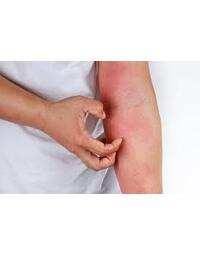What is the pathophysiology behind anaphylaxis

Do you ever administer medications or vaccines? Do you work in a primary or acute care setting? Chances are you will come across anaphylaxis at multiple times in your career. In fact, the prevalence of anaphylaxis is increasing - in Australia, hospital admissions for anaphylaxis have increased four-fold in the past 20 years to several thousand per year currently. Internationally, anaphylaxis has been estimated to affect up to 2% of people at some point across their lifespan.
Recognising and treating anaphylaxis in a timely manner is critical. In this article we give a brief overview of what anaphylaxis is and what we should know about managing it in the short and long term.
What is anaphylaxis?
In short, anaphylaxis is a rapid onset, multi-system hypersensitivity reaction to a specific allergen.
The classic definition of anaphylaxis is acute onset of typical skin features PLUS respiratory AND/OR cardiovascular AND/OR gastrointestinal symptoms[1].
You can diagnose anaphylaxis without any skin features if there is an acute onset of hypotension, bronchospasm, or upper airway obstruction, in a setting where anaphylaxis is considered possible.
What is the pathophysiology behind anaphylaxis?
Anaphylaxis is a hypersensitivity reaction. In most cases, it is IgE-mediated but either way, the final common pathway is activation and degranulation of mast cells and basophils, producing immune mediators such as histamine that cause the symptoms of anaphylaxis.
Ê
In IgE-mediated ("immune") anaphylaxis, there is an initial "sensitising" event followed by subsequent re-exposure where the anaphylactic reaction occurs. In the sensitising event, the allergen ("antigen") is picked up by the B cells which then produce antibodies specific to the antigen. Next time there is an exposure to the allergen, the antibodies bind to mast cells and basophils which then degranulate and release a variety of chemical mediators including histamine. These mediators cause the symptoms associated with an anaphylactic reaction:
- Vasodilation
- Fluid extravasation
- Smooth muscle contraction
- Increased mucosal secretions
Ê
In non IgE-mediated reactions ("non-immune"), there is no sensitising event. Instead, the allergen itself directly triggers the release of the chemical mediators from mast cells. A common cause of non-immune anaphylaxis is radiological contrast media.
Acutely, differentiating between immune and non-immune doesn't matter because the treatment is the same! Knowing the difference can be useful to know if pursuing prevention therapy such as immune modulation.
Acute management
If the allergen is still present (e.g. a stinger from an insect), this needs to be removed, and call for assistance, including an ambulance.
Adrenaline is the drug of choice for anaphylaxis (1:1000 at a dose of 0.01 mg/kg IM in the lateral thigh [maximum 0.5 mg]). This is administered intramuscularly, into the outer mid thigh as soon as practicable. Doses of adrenaline can be repeated 3-5 minutely until help arrives, but some patients may require an adrenaline infusion.
If the patient has a known diagnosis of asthma and is having breathing difficulties, salbutamol (Ventolin) can be administered after the adrenaline.
Fluid resuscitation may be required in severe cases. Always remember to monitor the patient's DRSABCD and address compromise as it occurs!
It is important to keep patients with anaphylaxis in a supine position. Sitting up can reduce venous return and may precipitate cardiac arrest. If the patient has difficulty breathing whilst supine, they can be cautiously brought upright, but close monitoring for hypotension is required.
Ê
Ongoing management
Most patients who have had an anaphylactic reaction will be observed in hospital for 4-6 hours after the reaction. This is to monitor for a biphasic reaction (a second anaphylactic reaction).
All patients who present with anaphylaxis for the first time should get a referral to a clinical immunology/allergy specialist. In the interim, an adrenaline autoinjector such as an EpiPen should be prescribed, education in its use given, and an Anaphylaxis Action Plan provided. In Australia, this action plan provides information regarding the signs of anaphylaxis, when to administer adrenaline, and when to give adrenaline/epinephrine.
A quick note on desensitisation ("allergen immunotherapy"): this is the closest thing we have to a cure for anaphylaxis in the long-term (although it's only used for certain allergens currently). It involves the administration of the allergen to allergic individuals in increasing doses over long periods of time. It essentially makes the body slowly build up tolerance of the allergen and reduces its tendency to produce an IgE-mediated response.
Written by Dr Freya BleathmanÊ(MBBS, University of Tasmania, Australia), who is one of the hosts of a paediatric medical education podcast called You're Kidding, Right?
References
Anaphylaxis, Recognition and Management, Volume 41, No.6, June 2012 Pages 366-370 https://www.racgp.org.au/afp/2012/june/anaphylaxis-recognition-and-management/
Australasian Society of Clinical Immunology and Allergy. Acute Management of Anaphylaxis guidelines, 2020. https://www.allergy.org.au/hp/papers/acute-management-of-anaphylaxis-guidelines
James J & Williams P, Anaphylaxis: Recognition and Management, American Family Physician, vol 84, no. 10, Nnov 2011, pp 1111-1118.
Kirkbright S & Brown S, Anaphylaxis: Recognition and Management, Australian Family Physician, vol 41, no. 6, June 2012, pp 366-370.
Mullins RJ, et al. The economic impact of allergic disease in Australia: not to be sneezed at. ASCIA/Access Economics Report, November 2007. www.allergy.org.au/content/view/324/76/
[1] Skin features: urticaria, angioedema, flushing. Respiratory features: bronchospasm, wheeze. Cardiovascular features: tachycardia, hypotension, syncope. Gastrointestinal features: vomiting, abdo pain.




